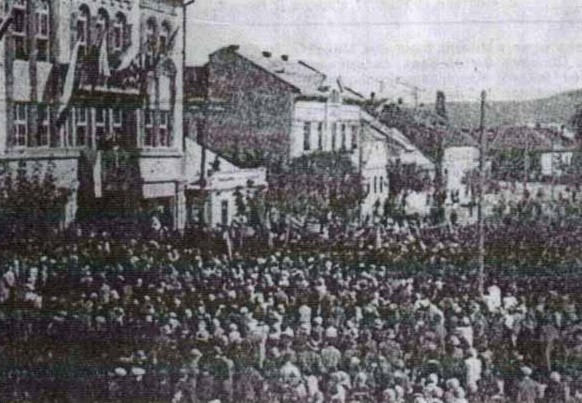People's homes
People's homes (народні доми or народні будинки; narodni domy or narodni budynky). Community centers that provide a venue for cultural, educational, and sometimes political activities. People's homes, called people's buildings in Russian-ruled Ukraine, housed everything from libraries, theaters, and tearooms to rudimentary collections of newspapers and books. Plays, lecture series, and social events were often held in urban people's homes. In the villages people's homes housed reading rooms and provided space for social and political activities. Collectively people's homes provided an infrastructure for Ukrainian community life independent of church and state.
People's homes were built first in Western Ukraine. The People's Home in Lviv (1849–1939), founded by the Supreme Ruthenian Council, with its 120,000-volume library and natural science, historical, archeological, and fine art museums, was one of the most ambitious people's homes and the model for homes throughout Ukraine. In Bukovyna people's homes were established later. The most important people's home in that region was founded in 1887 in Chernivtsi. In Transcarpathia people's homes were not established until the 1920s. Alongside those community centers formally called people's homes, similar facilities were often organized spontaneously by local groups. By 1939 the Prosvita society had built 1,475 community centers in Galicia. Even more numerous were the rudimentary public libraries and reading rooms.
In Russian-ruled Ukraine people's buildings were established at the beginning of the 20th century. Often constructed by zemstvo authorities, people's buildings were more closely tied to the state than were the people's homes in Western Ukraine. Even so, they provided an important social infrastructure for populist and social-democratic activists, sometimes to the dismay of the buildings' founders, who usually limited their agenda to educational and cultural issues. The Kyiv Trinity People's Building, today the Kyiv Operetta Theater, was built in 1902 through the efforts of the Kyiv Literacy Society. Staging theater productions for the enlightenment of workers, who were offered free tickets, was a central function of this people's building. Between October 1903 and March 1904, 13,100 workers attended plays at the Kyiv People's Building. Another people's building was built in the Kyiv suburb of Lukianivka in 1904.
Founded in 1903 by the Kharkiv Literacy Society, the Kharkiv People's Building was reputedly one of the best in the Russian Empire. In 1903 alone 54 plays (attended by 42,126 people), 7 concerts (attended by 2,590 people) and 4 literary-musical evenings, 3 of which were organized by workers (attended by 2,927 people), were held there. In 1901 a People's Building was founded in Poltava by the local literacy society, whose ranks included such luminaries as Mykhailo Kotsiubynsky and Panas Myrny. There were also people's buildings in Odesa, Zhytomyr, Lokhvytsia, Pryluky, and other cities in central and eastern Ukraine.
In the initial period of Soviet rule people's homes were actively supported and constructed by the regime. In June 1921 in Ukraine there were 4,322 people's buildings and Prosvita societies, 5,620 reading houses and selbudy, and 1,298 workers' clubs. In 1924, people's buildings were reorganized into workers' and village clubs and palaces and houses of culture. A similar reorganization took place in Western Ukraine after 1945.
Numerous people's homes have been built by Ukrainians in the diaspora. The oldest and most active people's home in Canada is the Winnipeg Ukrainian National Home, built in 1916. Ukrainian-Canadian people's homes co-ordinated their activities through the Union of People's Homes. Ukrainian-American people's homes are found in all major cities in the United States. The first American people's home was founded in New York. Ukrainian people's homes exist in all other areas of Ukrainian emigration, throughout Latin America, Australia, and Europe. In the interwar period a people's home was even established in Harbin, Manchuria.
Bohdan Kravtsiv, Christine Freeland
[This article originally appeared in the Encyclopedia of Ukraine, vol. 3 (1993).]
.jpg)

.jpg)